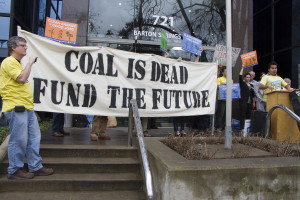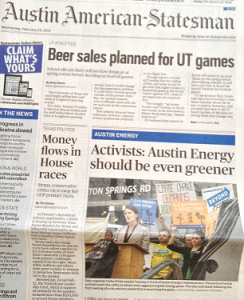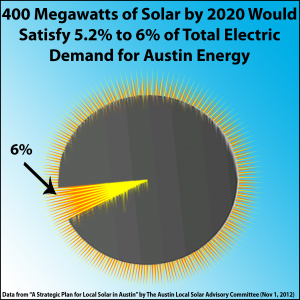
Austin Energy Ratepayers Rally for an Accelerated Transition to Affordable Renewable Energy
Photo by Al Braden
Read this post, then click here if you want to submit comments online to Austin Energy.
With 2 stakeholder meetings behind us and the final one ahead this afternoon, a lot of people are wondering what the purpose of of updating the Austin Energy Resource, Generation and Climate Protection Plan is if we aren’t going to update the goals in it.
To be fair, Austin Energy has done a decent job of providing information about how it is progressing with achieving current goals, and giving people an opportunity to share their views and ask questions.
What is so disconcerting though, is that Austin Energy has attempted to craft the whole update to exclude what is arguably the most important elements of the Resource, Generation and Climate Protection Plan – setting new goals for carbon reduction and renewable energy. We’re told we can submit proposals that will be analyzed and considered for some future update, but that there’s not enough time to update those goals now. Not enough time? We’re only 2 months in to 2014 and Austin Energy has been talking about this update since mid 2013. Let’s hope Austin Energy is more nimble than its giving itself credit for.
When it comes to solar energy, this idea that no new goals will be set is especially frustrating because the issue has been postponed for 2 years now. Increasing Austin Energy’s solar goal was on the table during the 2012 rate case, but Austin Energy wanted the issue studied. So City Council established the Austin Local Solar Advisory Committee (LSAC) to study options for a way forward for solar in Austin. The LSAC recommended several changes, including doubling the 2020 solar goal to 400 megawatts. It’s important to note that the LSAC analysis showed that increasing the goal would actually result in net savings to Austin Energy ratepayers, as well as a net of $300 million in economic benefits to the Austin area. When we tried to get that recommendation adopted in 2013, Austin Energy said it would be best taken up in the 2014 Generation Plan update, so City Council split the difference and passed a resolution recommending that the goal be adopted. Now Austin Energy says that it doesn’t intend to update any of it’s goals as part of this process. I’m starting to feel like the kid in the car on a long road trip and mom and dad just keep saying “we’re almost there.” After you hear that a few times, you just stop believing.
When it comes to the overall renewable energy goal, Austin Energy’s resistance to increasing it as part of this process makes even less sense for 2 reasons. First, renewable energy has become cheap energy. Wind is our cheapest energy option and solar is now competitive with natural gas, but without the risks of rising fuel costs and pollution. Second, Austin Energy has contracts that will allow it to meet it’s current 35% renewable energy goal 4 years early in 2016. They should build on that success and expand the goal to 50% for 2020 and 60% for 2024.
For anyone who isn’t stuck at work or class from 1pm to 3pm today, I suggest going to the last of Austin Energy’s 3 scheduled stakeholder meetings. Just don’t let them box you into a corner where the important issues are off the table. Tell the leadership and staff there that you want all of the goals updated over the next few months.




